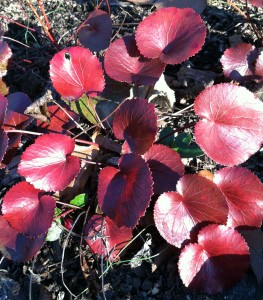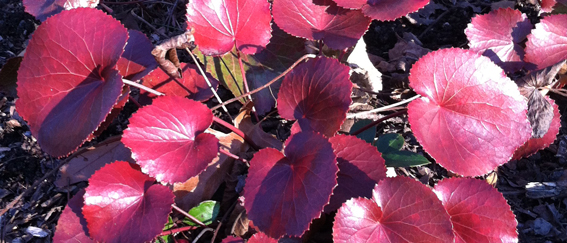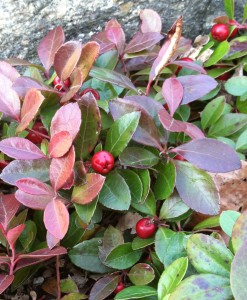Winter Woodland Wonders
Posted in Gardening Tips on December 18 2012, by Sonia Uyterhoeven
Sonia Uyterhoeven is the NYBG‘s Gardener for Public Education.

I have been spending the past few weeks in the Native Plant Garden, preparing the 2.5-acre site for winter. Most of my time has been spent cutting back foliage, raking leaves for shredding and returning to the garden as mulch, and tying together loose ends by updating the inventory of the collection. While much of the garden is going to bed, there are a few horticultural stars that are still out for the winter, and they look sublime at this time of year.
Three winter woodland wonders that caught my eye the other day were the wandflower (Galax urceolata), it close relative the rare Oconee bells (Shortia galacifolia) and the luscious-looking wintergreen (Gaultheria procumbens). All three are evergreen ground covers that do well in woodland shade but probably look their best in part-shade, where the canopy opens up to let in streams of light.
The wandflower (Galax urceolata) has glossy, rounded, heart-shaped leaves that look spectacular all year round. Once the cold weather sets in, the foliage starts to turn red. By the holiday season, the coloring is as intense as Rudolph’s red nose. Wandflower or Galax grow 12 to 16 inches tall with the flower spikes extending above the foliage like a narrow white bottle brush in late spring to early summer.
Wandflower is best planted en masse, skirting the edge of your azaleas, rhododendrons, blue berries or any other acid-loving shrub. Wandflower spreads on a shallow rhizome that creates a dense mass of foliage and flowers. It is a slow grower, so it will take a few years to fill in and look its best. Since the root system is shallow, it doesn’t like to dry out.

Adjacent to the wandflower in the Native Plant Garden is a large patch of wintergreen (Gaultheria procumbens) that trails down into a wide crevice between two rocks. Another exceptional native groundcover, wintergreen is known to all as a flavoring. While the flavor once came from the plant’s leaves, these days the wintergreen flavor that we taste in chewing gum and toothpaste is either made chemically or comes from black birch (Betula lenta).
Wintergreen has leathery, dark green elliptic leaves that take on a red tinge in the cool weather; it is not as dramatic as the wandflower, but still extremely attractive. The greatest ornamental value of wintergreen late in the season is the red fruit. In relation to the size of this diminutive, prostrate ground cover, the fruits are large and decorate the tiny stems like oversized costume jewelry. The fruit is edible and has a nice minty taste.

Wintergreen is sometimes listed as tea berry or boxberry. You will find some recipes on the web for teas and some use the berries sparingly as flavor for muffins and cookies. However, all wild edibles should be eaten with caution. It is not only imperative to correctly identify the plant (there are often many lookalikes in nature) but also in terms of proper preparation and quantity. Wintergreen leaves and berries contain methyl salicylate, which is similar to aspirin and has similar health warnings.
In recent years, wintergreen has become a diva for container designers forming part of their late season repertoire. When wintergreen is pampered in a container environment with regular watering and fertilizing, it fills out to form a dense mat. In the garden, however, wintergreen weaves around and creates a looser form. While Gaultheria procumbens prefers moist, cool sites to grow, it is better than many of its woodland counterparts at adapting to drier soils.
Next week we will look at a close relative of the wandflower, the rare Shortia galacifolia.


…this is so exciting….years ago I was a florist and used galax leaves to make a base for floral arrangements…first the moist foam in a dish, then a topping of moist moss, and a skirt of the leaves….it was a trademark of our design studio….
for some reason, I thought these leaves came from the south and now very few suppliers carry them. One time the supply dried up during wedding season and I panicked and used hosta and rhododendron…..never been a fan of fern in arrangements. The girl at our wholesaler told me that snakes came into the fields and it was not safe to pick the leaves. :)
We also used to put the leaves in water vials and slip in a cymbidium as a floral accent for a gourmet basket. This famous floral artist, Ronaldo Maia made a circular tablecloth of the leaves and also covered votives with them.
Your botanical knowledge is amazing. You seem to know about everything. Have a Merry Christmas!